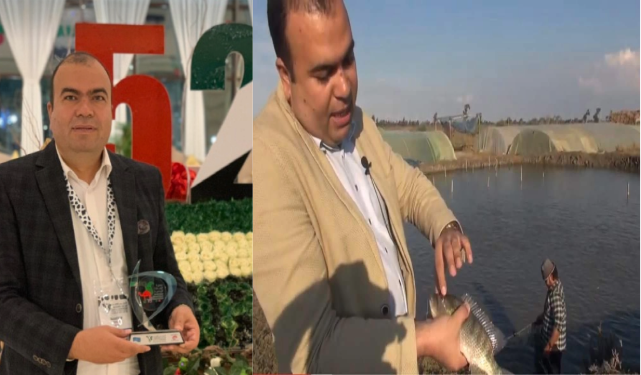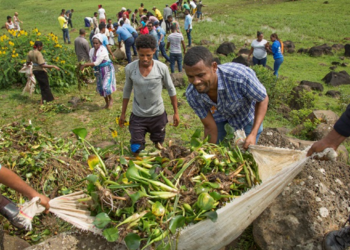Climate change and its impact on aquaculture: a message from Dr Youssef Elabd – Aquaculture faces significant challenges due to the increasing temperatures. Rising temperatures lead to a decrease in the amount of oxygen in the water, as warm waters cannot retain as much oxygen as cold ones. Oxygen-dependent fish will grow more slowly, decreasing in size and reproduce less frequently. Fish that require a large amount of oxygen will be compelled to move toward the more oxygen-rich surface waters also to reach their food and increasing competition for food.
Furthermore, marine organisms living on the seabed will also need to move towards shallower waters.
Dr Youssef Elabd Aquaculture expert, says that the extreme rise in temperatures due to climate change and global warming has become the suffering of the global aquaculture development.
Egyptian aquaculture is particularly vulnerable to these problems given the environmental conditions and the predominance of on-shore aquaculture.
The most important factors of these climatic influences are the following:
- The high percentage of carbon dioxide leads to an increase in its solubility in the waters of the oceans and seas, and an increase in the acidity of the water, which negatively affects the growth, reproduction and fish life.
- Climate change affects the distribution of stocks of freshwater and saltwater fish.
- Increasing the salinity of the waters in coastal lakes, crucial environments are going to change or be lost.
- The impact can also affect aquaculture farms (particularly on-shore), with the increase in water temperature, increased activity of thermophilic microbes, leading to an increase in the occurrence of diseases, as well as algal blooms and the resulting damage.
- High temperature also leads to a change in reproduction times, increased food consumption, increased organic residues and a lack of dissolved oxygen.
- The aquaculture fish juveniles are more affected by oxygen decreasing, thermal stress and the spread of diseases.
To mitigate the effects of climate change on aquaculture, adaptive measures and strategies should be implemented. These can include:
- Development of flexible aquaculture systems that can adapt to changing environmental conditions.
- Implement better water management practices to deal with changing water availability and quality.
- Investing in research and technology to develop more climate-resilient species and feed alternatives.
- Strengthen monitoring and early warning systems to anticipate and respond to climate related threats.
- Promote sustainable aquaculture practices to reduce environmental stress and contribute to climate change mitigation efforts.
Addressing the impacts of climate change on aquaculture requires collaborative efforts between policymakers, scientists, industry stakeholders, and local communities to ensure the long-term sustainability of aquaculture practices.

How to challenge and solve the impacts of climate change on aquaculture:
Addressing the impacts of climate change on aquaculture involves a multifaceted approach that combines adaptive strategies, technological innovations, and sustainable policy and practice changes. Here are several ways to challenge and provide solutions to mitigate the effects of climate change on aquaculture:
-
- Research and development of aquaculture species that are better able to adapt to changing environmental conditions, including temperature fluctuations, uneven water quality and disease resistance.
- Implement effective water management practices, such as aquaculture recycling systems or integrated multi-feed aquaculture, to optimize water use and reduce the impact of changes in water quality.
- Invest in habitat restoration projects to protect and restore vital ecosystems that support aquaculture. This can include the restoration of mangroves, the rehabilitation of coral reefs and the protection of coastal areas that serve as fish nurseries.
- Explore and use alternative and sustainable feed sources for aquaculture to reduce dependence on wild-caught fish for feed. This includes the use of feeds based on insects, algae and other plant substitutes.
- Develop and deploy early warning systems to monitor environmental changes, anticipate potential hazards, and allow timely adjustments in aquaculture practices to mitigate adverse impacts.
- Take advantage of technological advances such as sensors, remote monitoring systems and AI-based analytics to enhance monitoring, improve nutrition practices and improve water quality management.
- Encourage governments and regulators to support sustainable aquaculture practices through public policy measures, incentives for climate-resilient technologies, and regulations that enhance environmental stewardship.
- Educate aquaculture practitioners about the impacts of climate change and provide training on adaptive strategies, sustainable practices, and efficient use of resources.
- Promote collaboration between researchers, industry stakeholders, policymakers, and local communities to share knowledge, share best practices, and collectively address climate change-related challenges in aquaculture.
- Develop and implement long-term climate adaptation plans for aquaculture, taking into account regional and local differences in climate impacts and vulnerabilities.
Dr. Youssef added:
By combining these strategies and promoting a comprehensive approach to climate change adaptation in aquaculture, it is possible to mitigate negative impacts, enhance sustainability, and ensure the resilience of aquaculture systems in the face of changing environmental conditions.
Climate change and its impact on aquaculture: a message from Dr Youssef Elabd









